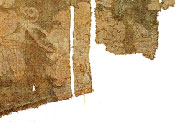 |
 |
|||||||||||||||||
 |
||||||||||||||||||
 |
||||||||||||||||||
| Classified Glossary | ||||||||||||||||||
 |
||||||||||||||||||
 |
||||||||||||||||||
| 18. 1Twill damask Specifically, twill damask refers to a self-patterned textile formed by a warp-faced and a weft-faced binding, such as the 4-end twill damask in the Tang dynasty. Commonly this term includes all damasks using a twill binding as ground, including: 1. twill damask with different directions (yixiangling); 2. twill damask with same direction (tongxiangling); 3. twill damask in different faces (yimianling); 4. twill damask with floats (fuwenling). Even more variations appear in the later periods than Tang dynasty. 19. 1Satin damask Specifically, satin damask (anhuaduan) refers to only a self-patterned textile formed by the contrast of a satin and the reverse of a satin binding. The term is also used to describe all self-patterned textiles on a ground with a satin binding. 5-end and 8-end damask were used in China since the early 14th century and 17th century respectively. When different colours are used in the warp and weft to create a variation in tone, the damask is called shot damask (shanduan). 20. 1Gauze In the West, the term gauze includes all textiles woven with a displaced warp, however in China, gauze is divided into sha and luo. Leno, which is also used, is not recommended by CIETA. Gauze could be categorized into simple gauze (jiandanshaluo) and complex gauze (fuzashaluo) according to the structure. |
||||||||||||||||||
| THE BOOK | ||||||||||||||||||
| AUTHOR | ||||||||||||||||||
| CONTENTS | ||||||||||||||||||
| ORDER | ||||||||||||||||||
| CONTACT | ||||||||||||||||||
| LINKS | ||||||||||||||||||